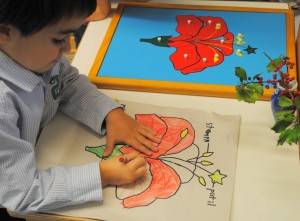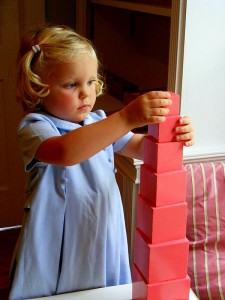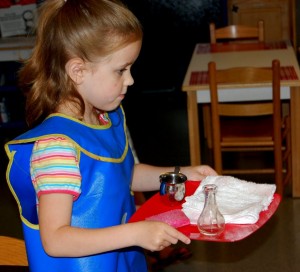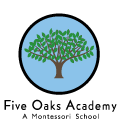 Our primary classrooms are set up to ensure the academic and social success for every child. This is achieved through our model of three Montessori certified teachers in each classroom. The typical model for children this age utilizes one teacher per classroom.
Our primary classrooms are set up to ensure the academic and social success for every child. This is achieved through our model of three Montessori certified teachers in each classroom. The typical model for children this age utilizes one teacher per classroom.
At Five Oaks Academy, we recognize and address the child’s need to have access to learning opportunities upon demand. This model fosters development of empowered and independent learners. While children are supported in decision making and work choice, they are also encouraged to begin the lifelong process of interdependence within a community. The arrangement in all of our classrooms fosters this essential life skill.
 Students in the primary classrooms begin their academic journey in the most concrete and impressionistic phase of Montessori education. Children learn to use various materials that illustrate, in a concrete sense, concepts that are being learned. These materials are designed to build upon one another and offer opportunities for the child to make connections between concepts through the vehicle of the material. Many of the materials in the primary classrooms are self-correcting, allowing children the independence and freedom of self-teaching. Use of materials creates a multidimensional learning experience, not only are children learning the concept at hand, but they are mastering the intricacies of using the material in coordination with a separate learning process. Children are introduced to concepts in Arithmetic, Geometry, Writing, Reading, Geography, History,World Cultures, Practical Life, Grace and Courtesy, Peace Education, Foreign Language, and Science through material presentations and work. The children are audience to visual demonstrations that give an impression of the relationship of our Universe to all things within it.
Students in the primary classrooms begin their academic journey in the most concrete and impressionistic phase of Montessori education. Children learn to use various materials that illustrate, in a concrete sense, concepts that are being learned. These materials are designed to build upon one another and offer opportunities for the child to make connections between concepts through the vehicle of the material. Many of the materials in the primary classrooms are self-correcting, allowing children the independence and freedom of self-teaching. Use of materials creates a multidimensional learning experience, not only are children learning the concept at hand, but they are mastering the intricacies of using the material in coordination with a separate learning process. Children are introduced to concepts in Arithmetic, Geometry, Writing, Reading, Geography, History,World Cultures, Practical Life, Grace and Courtesy, Peace Education, Foreign Language, and Science through material presentations and work. The children are audience to visual demonstrations that give an impression of the relationship of our Universe to all things within it.
 The primary students are allowed to work independently on self-selected work. The expectation is that the child will develop an inner motivation and will receive pleasure from the accomplishments that the work in the classroom brings. Children who demonstrate a need for more direction receive it; those who are self-directed are allowed to work independently. This invaluable experience begins the life long process of developing decision making skills and skills of prioritization, two skills that all people need throughout life.
The primary students are allowed to work independently on self-selected work. The expectation is that the child will develop an inner motivation and will receive pleasure from the accomplishments that the work in the classroom brings. Children who demonstrate a need for more direction receive it; those who are self-directed are allowed to work independently. This invaluable experience begins the life long process of developing decision making skills and skills of prioritization, two skills that all people need throughout life.





